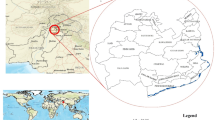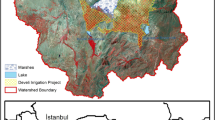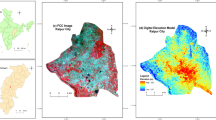Abstract
In this study, using Landsat 8 OLI satellite images, Duzce province 2013 and 2021 land surface temperature data were calculated and it was aimed to determine land surface temperature values according to land-use classes. In addition, correlations were examined according to six different vegetation indexes. In the areal distribution of land surface temperature data, it was determined that 59.7% of the entire area was distributed between 25 and 30 °C in 2013, and 53.3% between 20 and 25 °C in 2021. The normalized difference vegetation index, which is used extensively, especially in studies related to vegetation, has the highest average values of broad-leaved forest areas in both periods. In the relations between land surface temperature values and vegetation indexes, a positive correlation with normalized difference built-up index and a negative correlation with other vegetation indexes were found. Correlation values between land surface temperature and vegetation indexes in 2021 were higher than in 2013. The highest correlation values were obtained in the normalized difference built-up index in 2013 and 2021 with correlation values of 0.62 (R2: 0.39) and 0.73 (R2: 0.54), respectively. While a correlation of 0.68 (R2: 0.46) was found with the NDVI index in 2021, a correlation of 0.55 (R2: 0.30) was obtained in 2013. The lowest correlation was found in the renormalized difference vegetation index with ratios of 0.66 (R2: 0.44) in 2021 and 0.47 (R2: 0.22) in 2013. In addition, significant and positive spatial autocorrelations were obtained according to Moran I and LISA statistical analysis in both years. Moran's I values were found to be 0.607 (p < 0.05) in 2013 and 0.791 (p < 0.05) in 2021, and it was determined that there were significant clusters according to LISA. Understanding the effects of the spatial distribution of Land use-land change and its variation over time on the land surface temperature can be incorporated into environmental health and sustainable urban planning and contribute to planners.
















Similar content being viewed by others
Availability of data and material
The data that support the findings of this study are available from the corresponding author upon reasonable request.
References
Akyürek Ö (2020) Termal uzaktan algilama görüntüleri ile yüzey sicakliklarinin belirlenmesi: Kocaeli örneği. J Nat Hazard Environ 6(2):377–390. https://doi.org/10.21324/dacd.667594
Anselin L, Syabri I, Kho Y (2006) GeoDa: an introduction to spatial data analysis. Geogr Anal 38(1):5–22. https://doi.org/10.1111/j.0016-7363.2005.00671.x
Artis DA, Carnahan WH (1982) Survey of emissivity variability in thermography of urban areas. Remote Sens Environ. https://doi.org/10.1016/0034-4257(82)90043-8
Asner GP (1998) Biophysical and biochemical sources of variability in canopy reflectance. Remote Sens Environ 64:234–253
Balçık FB, Ergene EM (2017) Yer yüzey sıcaklığının termal uzaktan algılama verileri ile belirlenmesi: İstanbul örneği. Türkiye Ulusal Fotogrametri ve Uzaktan Algılama Birliği 9. Teknik Sempozyumu, Türkiye, ss 21.
Bokaie M, Zarkesh MK, Arasteh PD, Hosseini A (2016) Assessment of Urban Heat Island based on the relationship between land surface temperature and land use/land cover in Tehran. Sustain Cities Soc 23:94–104
Canty JM (2014) Image analysis, classification and change detection in remote sensing, with algorithms for envi/idl and python, 3rd edn. CRC Press, Boca Raton. https://doi.org/10.1201/b17074
Carlson TN, Ripley DA (1997) On the relation between NDVI, fractional vegetation cover and leaf area index. Remote Sens Environ 62:241–252
Chen XL, Zhao HM, Li PX, Yin ZY (2006) Remote sensing image-based analysis of the relationship between urban heat island and land use/cover changes. Remote Sens Environ 104(2):133–146
Crippen RE (1990) Calculating the vegetation index faster. Remote Sens Environ 34:71–73
Coluzzi R, Masini N, Lanorte A, Lasaponara R (2010) On the estimation of fire severity using satellite ASTER data and spatial autocorrelation statistics. In: Computational science and its applications-ICCSA, pp. 361– 373
Çelebioğlu F, Dall’Erba S (2010) Spatial disparities across the regions of Turkey: an exploratory spatial data analysis. Ann Reg Sci 45(2):379–400
Çetin M (2015) Using GIS analysis to assess urban green space in terms of accessibility: case study in Kutahya. Int J Sust Dev World 22(5):420–424
Erener A, Sarp G (2018) Spatiotemporal distribution of ındustrial regions and impact on LST in the case of Kocaeli. In: FIG Congress 2018 Proceedings, İstanbul
Feng H, Zhao X, Chen F, Wu L (2014) Using land-use change trajectories to quantify the effects of urbanization on urban heat island. Adv Space Res 53(3):463–473
Gerçek D, Bayraktar NT (2014) Kentsel ısı adası etkisinin uzaktan algılama ile tespiti ve değerlendirilmesi: İzmit kenti örneği, 5. Uzaktan Algılama-CBS Sempozyumu, İstanbul. http://www.uzalcbs2014.sempozyumu.net/bildiriler.phd.
GDF (2018) General Directorate of Forestry. Orman Amenajman Planları, Ankara
Gitelson AA, Kaufman YJ, Merzlyak MN (1996) Use of a green channel in remote sensing of global vegetation from EOS-MODIS. Remote Sens Environ 58:289–298
Gorgani SA, Panahi M, Rezaie F (2013) The Relationship between NDVI and LST in the urban area of Mashhad, Iran. https://www.researchgate.net/publication/265601825
Imran HM, Anwar H, Saiful Islam AKM, Rahman A, Abul Ehsan Bhuiyan MD, Paul S, Alam A (2021) Impact of land cover changes on land surface temperature and human thermal comfort in Dhaka city of Bangladesh. Earth Syst Environ. https://doi.org/10.1007/s41748-021-00243-4
Krtalić A, Divjak AK, Čmrlec K (2020) Satellite-driven assessment of surface urban heat islands in the city of Zagreb, Croatia. ISPRS Ann Photogramm Remote Sens Spat Inf Sci 3:757–764
Kumar D, Shekhar S (2015) Statistical analysis of land surface temperature–vegetation indexes relationship through thermal remote sensing. Ecotoxicol Environ Saf 121:39–44
Lin CY, Chen WC, Chang PL, Sheng YF (2011) Impact of the urban heat island effect on precipitation over a complex geographic environment in northern Taiwan. J Appl Meteorol Climatol 50(2):339–353
Li ZL, Tang BH, Wu H, Ren H, Yan G, Wan Z, Trigo IF, Sobrino JA (2013) Satellite-derived land surface temperature: current status and perspectives. Remote Sens Environ 131:14–37
Malik MS, Shukla JP, Mishra S (2019) Relationship of LST, NDBI and NDVI using landsat-8 data in Kandaihimmat watershed, Hoshangabad
Mallick J, Kant Y, Bharath BD (2008) Estimation of land surface temperature over Delhi using Landsat ETM+. J Indian Geophys Union 12(3):131–140
Mallick J, Kumar Singh C, Shashtri S, Rahman A, Mukherjee S (2012) Land surface emissivity retrieval based on moisture index from Landsat TM satellite data over heterogeneous surfaces of Delhi city. Int J Appl Earth Obs Geoinf 19:348–358
Moran P (1948) The Interpretation of statistical maps. J Roy Stat Soc 10:243–251
Oke TR (1982) The energetic basis of the urban heat island. Q J R Meteorol Soc 108(455):1–24
O’Sullivan D, Unwin D (2002) Geographic information analysis. John Wiley & Sons, New York, p 432. ISBN:0471211761
Özelkan E, Papila I, Uca Avci DZ, Karaman M (2011) Drought determination by using land surface temperature and normalized difference vegetation index, 34th. In: International symposium on remote sensing of environment -The GEOSS Era: towards operational environmental monitoring, Sydney, pp. 1–4.
Peng X, Wu W, Zheng Y, Sun J, Hu T, Wang P (2020) Correlation analysis of land surface temperature and topographic elements in Hangzhou, China. Sci Rep 10:10451. https://doi.org/10.1038/s41598-020-67423-6
Prata AJ, Caselles CC, Sobrino JA, Ottle C (2009) Thermal remote sensing of land surface temperature from satellites: current status and future prospects. Remote Sens Rev 12:175–224
Qin Z, Karnieli A (1999) Progress in the remote sensing of land surface temperature and ground emissivity using NOAA±AVHRR data. Ben-Gurion University of the Negev, Israel
Qin Z, Karnieli A, Berliner P (2001) A mono-window algorithm for retrieving land surface temperature from Landsat TM data and its application to the Israel-Egypt border region. Int J Remote Sens 22(18):3719–3746
Richard JU, Andrew A (2019) Derivation of land surface temperature (LST) from Landsat 7 & 8 imageries and its relationship with two vegetation indices (NDVI and GNDVI). Int J Res Granthaalayah 7(2):108–120. https://doi.org/10.29121/granthaalayah.v7.i2.2019.1013
Roujean JL, Breon FM (1995) Estimating PAR absorbed by vegetation from bidirectional reflectance measurements. Remote Sens Environ 51:375–384
Santamouris M, Cartalis C, Synnefa A, Kolokotsa D (2015) On the impact of urban heat island and global warming on the power demand and electricity consumption of buildings—a review. Energy Build 98:119–124
Shoukat AS, Madeeha K, Aleena N, Rabia D (2021) Evaluation of land surface temperature and normalized difference vegetation index relationship using Landsat 8 satellite images in Mehar Taluka Dadu, Pakistan. J Geol 5(2):62–71. https://doi.org/10.2478/pjg-2021-0008
Streiling S, Matzarakis A (2003) Influence of single and small clusters of trees on the bioclimate of a city: a case study. J Arboric 29(6):309–316
Sobrino JA, Jimenez-Muoz JC, Soria G, Romaguera M, Guanter L, Moreno J, Plaza A, Martinez P (2008) Land surface emissivity retrieval from different VNIR and TIR sensors. IEEE Trans Geosci Remote Sens 46(2):316–327
Sobrino JA, Li ZL, Stoll MP, Becker F (1996) Multi-channel and multi-angle algorithms for estimating sea and land surface temperature with ATSR data. Int J Remote Sens 17(11):2089–2114
Sun Q, Tan J, Xu Y (2010) An ERDAS image processing method for retrieving LST and describing urban heat evolution: a case study in the Pearl River Delta Region in South China. Environ Earth Sci 59:1047–1055
Şekertekin AI, Marangoz AM (2019) Zonguldak metropolitan alanındaki arazi kullanımı arazi örtüsünün yer yüzey sıcaklığına etkisi. Geomatik Dergisi 4(2):101–111
Şensoy S, Şahin L, Yılmaz E, Türkoğlu N, Çiçek İ, Darende V, Yazıcı B (2017) Antalya yüzey ısı adası özelliklerinin uydu verileri ile analizi, III. Meteorolojik Uzaktan Algılama Sempozyumu, Ekim, Antalya, pp. 16–19.
Taşdelen Ö (2019) Yer yüzey sıcaklık haritalarının yerel ve ülke ölçeğinde zamansal ve mekansal olarak uzaktan algılama ile tespiti, Master thesis, Kocaeli Üniversitesi, Fen Bilimleri Enstitüsü, Kocaeli
Tobler WR (1970) A computer model simulating urban growth in the detroit region. Econ Geogr 46:234–240
TMS (2022) Turkish state meteorological service. Access link: https://www.mgm.gov.tr/eng/forecast-cities.aspx?m=DUZCE
Tucker CJ (1979) Red and photographic infrared linear combinations for monitoring vegetation. Remote Sens Environ 8:127–150. https://doi.org/10.1016/0034-4257(79)90013-0
USGS (2021) Landsat Missions, (Landsat 8). Accessed 15 Mar 2022, at https://www.usgs.gov/core-science-systems/nli/landsat
Weng Q, Lu D, Schubring J (2004) Estimation of land surface temperature-vegetation abundance relationship for urban heat island studies. Remote Sens Environ 89(4):467–483
Xu H (2007) Extraction of urban built-up land features from Landsat imagery using a thematic-oriented index combination technique. Photogramm Eng Remote Sens 73:1381–1391
Yılmaz E (2015) Landsat görüntüleri ile Adana yüzey ısı adası. Coğrafi Bilimler Dergisi 13(2):115–138
Zhang N, Qin Q, Nan P, Chai L (2011) Geothermal area detection using Landsat ETM+ thermal infrared data and its mechanistic analysis—a case study in Tengchong, China. Int J Appl Earth Obs Geoinform 13(4):552–559
Zhu SY, Yin Q, Kuang DB (2006) Using characteristic spectral bands of OMIS1 imaging spectrometer to retrieve urban land surface temperature. Int J Remote Sens 27(8):1661–1676. https://doi.org/10.1080/01431160500462147
Funding
No funding.
Author information
Authors and Affiliations
Contributions
Methodology, Original writing drafted, reviewed and edited by the author ASD.
Corresponding author
Ethics declarations
Conflict of interest
The author declares that he/she has no conflict of interest.
Ethical approval
This research did not require ethics approval.
Additional information
Editorial responsibility: Samareh Mirkia.
Rights and permissions
Springer Nature or its licensor (e.g. a society or other partner) holds exclusive rights to this article under a publishing agreement with the author(s) or other rightsholder(s); author self-archiving of the accepted manuscript version of this article is solely governed by the terms of such publishing agreement and applicable law.
About this article
Cite this article
Değermenci, A.S. Estimation of land surface temperature from Landsat-8 OLI: comparative analysis of two periods for Duzce in Turkey. Int. J. Environ. Sci. Technol. 21, 6389–6404 (2024). https://doi.org/10.1007/s13762-023-05416-4
Received:
Revised:
Accepted:
Published:
Issue Date:
DOI: https://doi.org/10.1007/s13762-023-05416-4




